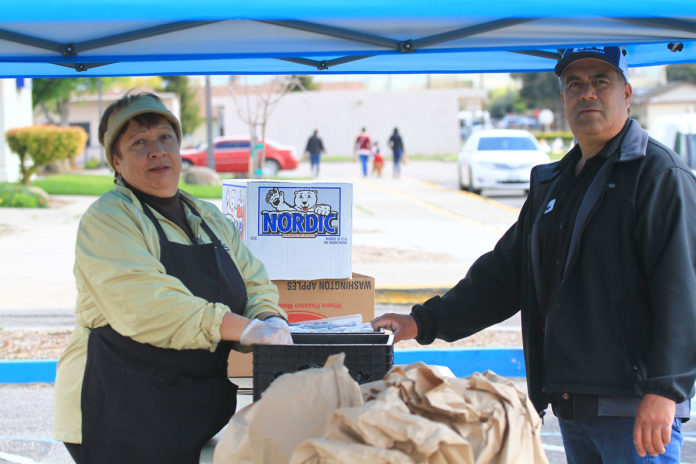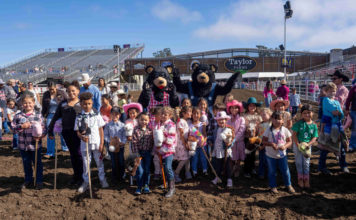
SALINAS VALLEY — Area schools have begun offering free food to children from age 1 through 18. Times and plans differ by city, but they all have the same mission, to ensure area youth have a reliable source of food during the coronavirus-related closure of California public schools.
King City and Greenfield high schools offer meals between 8:30 a.m. and 12 p.m. In King City, Del Rey Elementary School and King City Arts Magnet School hand out meals from 10 a.m. to 12 p.m. Greenfield elementary schools host a breakfast and lunch pickup from 8:30 to 10:30 a.m.
All school sites in Soledad offer meal pick-up between 11 a.m. and 1 p.m., while all Gonzales schools host meal pick-ups from 8 a.m. to noon.
Meal pick-ups are on weekdays, with youth or families able to walk up or adults able to drive up during the distribution.
“They’ll drive through and we’ll ask how many children, because it’s for children,” said Chris Artea, food services director for King City Union School District.
Artea noted that children do need to be present, per national school lunch regulations.
“We’ll give them their breakfast and lunch, so they’re going to get both meals,” Artea said about the meal packages that children will receive.
Soledad is another district that offers a single mealtime, where students pick up lunch and breakfast at the same time.
“All of our food service staff are still on duty because it takes all of them to get the meals ready,” said Elizabeth Wilson, chief business officer for Soledad Unified School District.
Soledad offers students an option for a hot or cold lunch; for example, the choice between a sandwich and a burrito, while the breakfasts are cold.
The ability for any youth to go to any school site means more efficiency for families.
“A parent who has a student at an elementary school, the middle school and the high school doesn’t have to go to three places, they can pick them up at one because all of the meals are the same,” Wilson said.
The numbers of school meals served began in the hundreds for all sites, and has continued to grow as word of mouth spreads, even after efforts by all districts to initially contact families through email, phone calls, texts, website and social media posts.
By last Thursday, Soledad was already serving more than 1,200 meals per day.
“Each day we get a little better at what we’re doing,” Wilson said.
Gonzales also offers a double meal, with students having the option to get a single meal.
During the meal pickups, students and their families are not allowed to enter the school buildings, which is why they may drive or walk up. All schools have advised students and their families to observe social distancing and not congregate when forming lines.
“People are understanding,” Wilson said. “They’re happy that food is being provided.”
For schools that offer one mealtime, a single window of time limits the chances of exposure for students, their families and school staff.
Emergency planning
Plans to get meal services rolling came suddenly for all schools. While the King City elementary schools were on Spring Break during the state announcement of a closure of schools, others were in session.
“It was very quick,” said Jeffrey Pfundtner, certified dietary manager for Greenfield Union School District. “We found out on Friday and started delivering Monday morning.”
Pfundtner noted having a plan in place so quickly relied on adaptability on the part of staff and the many ideas in a team effort by administration. The efforts have come through thanks to many hours of dedicated work by classified staff.
“All of our food service staff continue to do the service,” Pfundtner said. “We want to be able to continue serving at the same level that we have been providing.”
The planning began by taking what schools knew of their usual food service levels and going from there as a baseline.
Outlying students
While schools are required to provide meals and make them available, the districts have the option to seek out their outlying areas where students would normally be bused in during regular school days.
In Soledad, the district brings meals to the Camphora area with two housing tracts because of the concentration of students at those locations.
Gonzales has sent deliveries to local bus stops and camps to ensure students are fed.
In Greenfield, drivers take meals to students who would normally take the bus. After the meals are handed out, any remaining meals are delivered to areas of need within the city, which includes apartment complexes.
“It was really satisfying to see those kids running up to the bus and grabbing their meal, because we know some of them might not be eating if it wasn’t for the meals we’re serving,” Pfundtner said.
Deliveries have taken coordination with city staff in Greenfield.
“People are scared now and they don’t want to come out,” Pfundtner said. “We’re still going to be going out in the community and working with the police department and first responders, who use the blow horn to speak in Spanish.”
Supplies and logistics
While grocery stores have caused concern with supply shortages, school districts have different supply chains and order their food and supplies well in advance.
“Food will not be a problem for us,” Wilson said. “Our suppliers are more of the industrial suppliers and our orders usually go in two weeks in advance and they come to us in big truckloads.”
Greenfield had to adjust their menu, due to serving more hot meals, some of which would have liquid content. That is more difficult to do in portable containers, so meals are prepared that can be portable and served from warming containers in batches after being prepared.
“Our suppliers have worked with us on that,” Pfundtner said. “I’ve ordered all the food for the district through the end of April. Our suppliers have been really good about filling in.”
One major adjustment for Greenfield has been an increase in the order for milk.
“We’re an ‘offer vs. serve’ with the milk, because some kids have intolerances, but when we pack out bags to go out into the community, we have to have the milk in them and we’re running through more,” Pfundtner said.
While the food supply hasn’t been a problem for schools, one quirk from handing out bagged lunches popped up in Greenfield.
“The only issue we had in the beginning was the brown bags, getting enough of those,” Pfundtner said. “We cleaned out a couple of the local suppliers. We’ve gone through our two big distributors out of the bay area and we pre-ordered enough through the end of next month.”
Pfundtner explained he has coordinated with Artea in King City to make sure students in the neighboring city will have enough bags for their lunches, as well.
“I’m glad we can work together and share this information on how we’re making it work,” Pfundtner said about the collaboration between cities and districts. “We might be different communities, but we’re all tied together, down here in South County and we have to take care of each other.”
Homework handout
In addition to picking up food, students have been able to pick up homework packets. Meeting the educational needs of students has begun with packets, while teachers work to figure out the next steps in distance learning.
School districts like Greenfield have begun sending out classroom Chromebooks to students who do not have a computer at home, while other districts are still assessing which students to send technological help to.
In Gonzales, teachers had 48 hours to prepare two weeks worth of packets for every grade level.
“They seem to be very happy to come and get their lunches and homework packets and be back at school,” said Mark Demick, principal at La Gloria Elementary School in Gonzales.
There, food services employees hand out lunches while maintenance and transportation staff members drive to deliver lunches. Teachers volunteer to arrange and hand out packets.
Demick said students have been appreciative of the homework.
“The kids are getting restless at home and want the packets,” he said.
Regarding the plans to move forward in Gonzales, Demick said, “We’re going to move from reviewing, because the packets are about reviewing, to learning, so we’re pushing out how to access different web pages and learning online. We have a teacher who showed how she set up a YouTube classroom for her own kids at home.”
Together, teachers are figuring out not only how to conduct lessons, but get students to do science experiments, reading and having family story time with their parents.
“This is transforming education,” Demick said. “It’s going to become a regular school day and it’s happening really quickly.”















